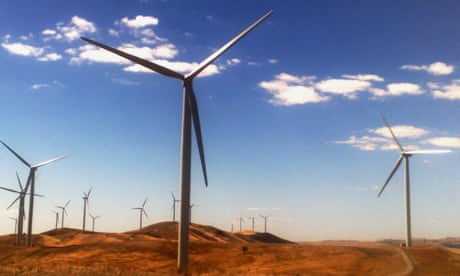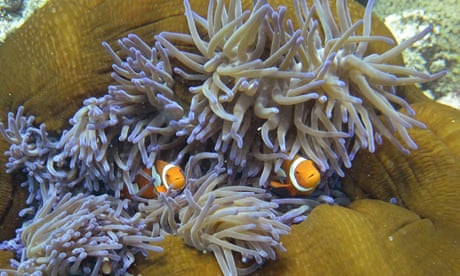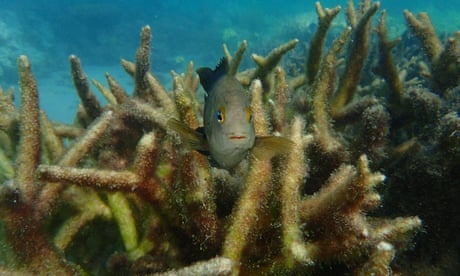Some in the sector fear the government is trying to defund the Clean Energy Finance Corporation by stealth. The truth may be a little more mundane
 |
| A 'reef fund' will be created with $1bn of Clean Energy Finance Corporation money if the Coalition returns to office. Photograph: Alamy |
These announcements left some clean energy sector experts crying foul, saying the government was trying to squeeze the CEFC for every last drop, and defund it by stealth.
That might be the case but the truth could be more mundane. The announcements probably amount to little, leaving the spending pledges bereft of substance – but equally doing little to harm the CEFC.
 By anyone's reckoning, the CEFC has been a success. According to its
2015 annual report, it invested $1.4bn, financing projects worth a total
of $3.5bn, which would reduce 4.2m tonnes of CO2-equivalent emissions
annually. And it did all that while making a profit.
But under the Tony Abbott, who called the CEFC "Bob Brown's bank", the Coalition tried unsuccessfully to abolish it, tried unlawfully to stop it operating, and tried – also possibly unlawfully – to stop it investing in windfarms and small-scale solar.
By anyone's reckoning, the CEFC has been a success. According to its
2015 annual report, it invested $1.4bn, financing projects worth a total
of $3.5bn, which would reduce 4.2m tonnes of CO2-equivalent emissions
annually. And it did all that while making a profit.
But under the Tony Abbott, who called the CEFC "Bob Brown's bank", the Coalition tried unsuccessfully to abolish it, tried unlawfully to stop it operating, and tried – also possibly unlawfully – to stop it investing in windfarms and small-scale solar.When Turnbull became prime minister he conceded the government had failed to abolish the CEFC but stopped short of giving it his backing.
"We do not support government banks performing roles that can be performed by the private sector … yes it has done some good work, the question is whether it is an appropriate use of government money," he said in question time in October, refusing to concede it played a "crucial" part in Australia's emissions reduction.
But now it is certainly playing a crucial role in Turnbull's re-election campaign.
So far, more than $2bn of the CEFC's money has been leveraged as election commitments. First Turnbull suggested up to $100m from the CEFC and EFIC (a similar organisation that finances export ventures) could be used to provide a loan for South Australia's steel industry. Then last week $1bn was carved off for a so-called "reef fund". And on Monday another $1bn of the CEFC's money was used to fund Turnbull's "smart cities" policy.
Together with Turnbull's earlier move to defund the Australian Renewable Energy Agency and take $1bn from the CEFC to make a new Clean Energy Innovation Fund in its place, John Grimes from the Solar Council – Australia's peak solar industry body – is convinced this is all part of a covert plan to abolish the CEFC.
"Their agenda has been very clear all along, to abolish the Clean Energy Finance Corporation," Grimes said. "What Malcolm Turnbull is doing it is abolishing it by other means.
"He's making a series of announcements where he's trying to get kudos … but actually what he's doing is taking the funding that is essential to push forward the renewable energy projects and help transition the economy, and using them for other purposes."
But without a change to the CEFC Act – which the government hasn't flagged any intention to pursue – no government decision can stop the CEFC from doing its best to "facilitate increased flows of finance into the clean energy sector".
Grimes said that was no comfort, since the Coalition hadn't promised not to amend the act if it had the numbers after the election.
Ariane Wilkinson from Environment Justice Australia said that limiting the scope of what the CEFC could invest in by too much could fall foul of the law – as was suggested could have been the case when the Coalition government tried to stop the CEFC from investing in windfarms.
But assuming it stays within the law, and doesn't try to change the legislation, what do these policy announcements amount to? Probably not much, in the end.
Take last week's reef announcement. The policy was that the CEFC would be directed to invest $1bn into projects that tackled both climate change and water quality issues on the Great Barrier Reef.
Jon Brodie is one of Australia's leading experts on water quality and coral reefs. He's been involved in writing hundreds of technical reports on the matter and authored a plan for how to improve water quality on the reef.
 Guardian Australia asked him which of those recommendations could be
assisted by money loaned to clean energy projects. "Well, I wouldn't
have thought any of them," he said.
Guardian Australia asked him which of those recommendations could be
assisted by money loaned to clean energy projects. "Well, I wouldn't
have thought any of them," he said.Stuart Bunn is director of the Australian Rivers Institute at Griffith University. Asked what sorts of projects could be funded with CEFC loans, he replied: "The odd thing is that nothing really leaps to mind."
He said that even if there were water quality projects that could be funded with loans for clean energy projects, they would be futile, since there were very particular locations and farmers that needed to be targeted, and incentive schemes like low-interest loans were unlikely to target those precise spots.
Cane farmers – the main target for water quality projects – have also said they're unsure how the financing could be used.
What's more, it's probably not really a $1bn fund, in any meaningful sense. A spokesman for the environment minister, Greg Hunt, said the fund would provide "up to" $1bn.
And we can be sure that, as with all CEFC money, it won't be spent unless the projects stack up.
What's more, the Coalition has said the fund will be used to fight both climate change and water quality. But despite being asked several times, Hunt's office has so far refused to answer questions about whether any percentage of the fund will be required to be spent on projects with water-quality co-benefits.
In response to that questioning, Hunt's office said climate change was the biggest long-term threat facing the Great Barrier Reef. But if it was including funding for climate change mitigation as part of a "reef fund", it might as well claim the full $10bn in the CEFC as part of it.
The "smart cities" policy funding looks similar. The CEFC already spends money on "smart cities" projects. Financing commercial buildings already happens. In fact commercial buildings are the second biggest sector to receive loans from the CEFC. In 2014 the chief excecutive of the CEFC, Oliver Yates, delivered a detailed presentation on how the CEFC was working to "making cities liveable". "The CEFC has been playing a role in this space to date," says Kane Thornton, chief executive of the Clean Energy Council. "I'm not sure if this changes things substantially."
But Thornton thinks the directive from the government to focus on clean energy projects in cities will give the CEFC some renewed focus on that sector. "There will be more opportunities and more scope for cities, local councils, building managers etcetera to go down the clean energy path."
And overall, Thornton said the CEFC had so much money to throw around that these limitations on where it could lend its money can spend its money weren't going to negatively impact the industry.
 "I think it would be an issue if the CEFC only had a small amount of
resources at its disposal but it does have a significant pool of funds
to invest and these sorts of directives are within its scope, and I
think it helps to give it some focus rather than depleting its funds."
"I think it would be an issue if the CEFC only had a small amount of
resources at its disposal but it does have a significant pool of funds
to invest and these sorts of directives are within its scope, and I
think it helps to give it some focus rather than depleting its funds."But that is exactly what other groups have picked up as the key problem with the announcement. "This is another politically driven, piecemeal policy that sees us yet again responding to a political need rather than building a decent plan for our future energy needs," said Claire O'Rourke, national director of Solar Citizens, a group that represents households with rooftop solar.
She said these moves distracted from what the CEFC was really designed to do. "The global transition to renewables is already under way. Australia needs a national plan to harness the multibillion-dollar renewables boom and manage the orderly transition to 100% clean renewable power," she said.
"Australia stands to gain an $800bn slice of the global renewable energy investment boom, and we will miss out on jobs, growth and investment if we don't get on with it now – this is what the CEFC is really for."
The plundering of CEFC funds – using it as an election slush fund – isn't likely to hurt the clean energy industry much, but it is unlikely to do any good either.
Links
- Boost renewable energy target to 50% and get 28,000 extra jobs, says report
- Great Barrier Reef needs $10bn for chance of survival, scientists say
- Saving Great Barrier Reef from climate change should be central election issue, says Tim Flannery
- Voters trust Coalition with economy and Labor with climate change, poll shows
- Q&A recap: vote me out next election if you don't like tax cuts, Turnbull says
- Wentworth activists GetUp to mischief with Malcolm Turnbull's election posters

No comments :
Post a Comment